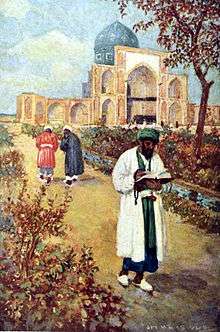Jay Hambidge

Jay Hambidge (1867–1924) was a Canadian born American artist. He was a pupil at the Art Students' League in New York and of William Chase, and a thorough student of classical art. He conceived the idea that the study of arithmetic with the aid of geometrical designs was the foundation of the proportion and symmetry in Greek architecture, sculpture and ceramics. Careful examination and measurements of classical buildings in Greece, among them the Parthenon, the temple of Apollo at Bassæ, of Zeus at Olympia and Athenæ at Ægina, prompted him to formulate the theory of "dynamic symmetry" as demonstrated in his works Dynamic Symmetry: The Greek Vase (1920) and The Elements of Dynamic Symmetry (1926). It created a great deal of discussion, an English critic saying that Hambidge did not try to formulate a new theory, but to recover a lost technique. He found a disciple in Dr. Lacey D. Caskey, the author of Geometry of Greek Vases (1922).
A number of notable artists have used dynamic symmetry in their painting, including George Bellows (1882–1925),[1] Maxfield Parrish (1870–1966),[2] Al Nestler (1900-1971),[3][4] The New Yorker cartoonist Helen Hokinson, and Clay Wagstaff (1964-).[5] and Kathleen Munn as in the recently published eBook by Georgiana Uhlyarik, Canada Art Institute[6]
Dynamic symmetry
Dynamic symmetry is a proportioning system and natural design methodology described in Hambidge's books. The system uses dynamic rectangles, including root rectangles based on ratios such as √2, √3, √5, the golden ratio (φ = 1.618...), its square root (√φ = 1.272...), and its square (φ2 = 2.618....), and the silver ratio ().[7][8]
From the study of phyllotaxis and the related Fibonacci sequence (1, 1, 2, 3, 5, 8, 13, 21, 34, 55, 89, 144, ...), Hambidge says that "a much closer representation would be obtained by a substitute series such as 118, 191, 309, 500, 809, 1309, 2118, 3427, 5545, 8972, 14517, etc. One term of this series divided into the other equals 1.6180, which is the ratio needed to explain the plant design system."[9] This substitute sequence is a generalization of the Fibonacci sequence that chooses 118 and 191 as the beginning numbers to generate the rest. In fact, the standard Fibonacci sequence provides the best possible rational approximations to the golden ratio for numbers of a given size.
References
- ↑ Bellows, George. 1979. George Wesley Bellows: paintings, drawings, and prints. Columbus, Ohio: Columbus Museum of Art. pp. 3–4. OCLC 5271681.
- ↑ Ludwig, Coy L., Diane Casella Hines, Robert Fillie, James Craig. 1973. Maxfield Parrish. New York, NY: Watson-Guptill Publications. p. 142. ISBN 0823038971.
- ↑ Moods in Oils and Felt Pens. Walter T. Foster, Tustin. 1965 ASIN B000BJTB32
- ↑ Color and Composition. Walter T. Foster, Tustin. 1965 ASIN B000BJOB8W
- ↑ New American Paintings No. 48, p. 153. The Open Studios Press, Boston, 2003.
- ↑ http://www.aci-iac.ca/kathleen-munn/significance-and-critical-issues
- ↑ Hambidge, Jay (2003) [1920]. Dynamic Symmetry: The Greek Vase (PDF) (Reprint of original Yale University Press ed.). Whitefish, MT: Kessinger Publishing. pp. 19–29. ISBN 0-7661-7679-7.
- ↑ Matila Ghyka (1977). The Geometry of Art and Life. Courier Dover Publications. pp. 126–127.
- ↑ Hambidge (1920) p. 159; note that his cited ratio 1.6180 is exact only for the pair 500, 809.
External links
- Works by Jay Hambidge at Project Gutenberg
- Works by or about Jay Hambidge at Internet Archive
- Hambidge Center for Creative Arts and Sciences
-
 This article incorporates text from a publication now in the public domain: Gilman, D. C.; Thurston, H. T.; Colby, F. M., eds. (1905). "article name needed". New International Encyclopedia (1st ed.). New York: Dodd, Mead.
This article incorporates text from a publication now in the public domain: Gilman, D. C.; Thurston, H. T.; Colby, F. M., eds. (1905). "article name needed". New International Encyclopedia (1st ed.). New York: Dodd, Mead.